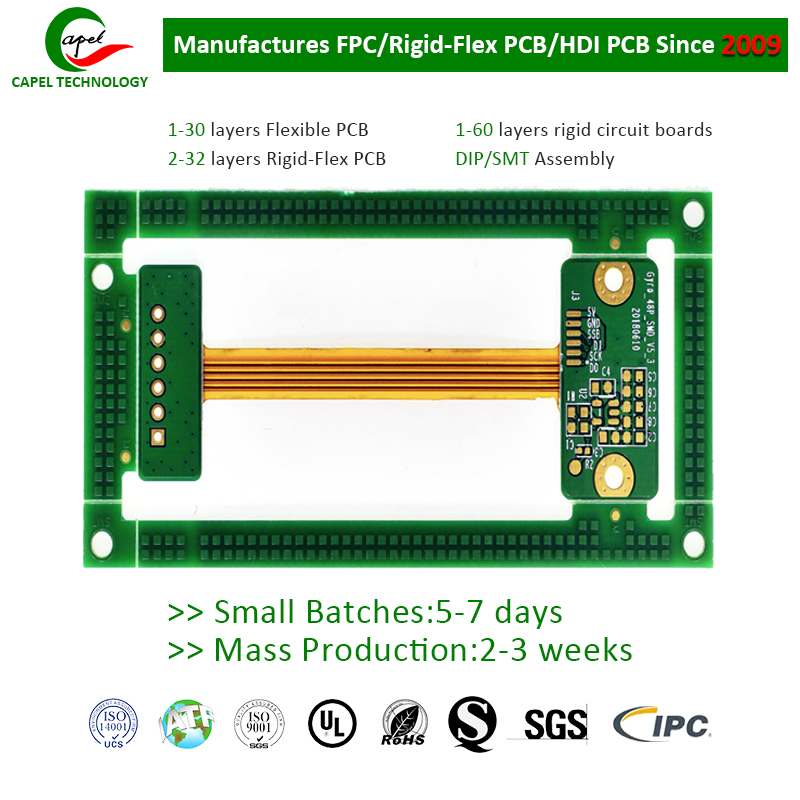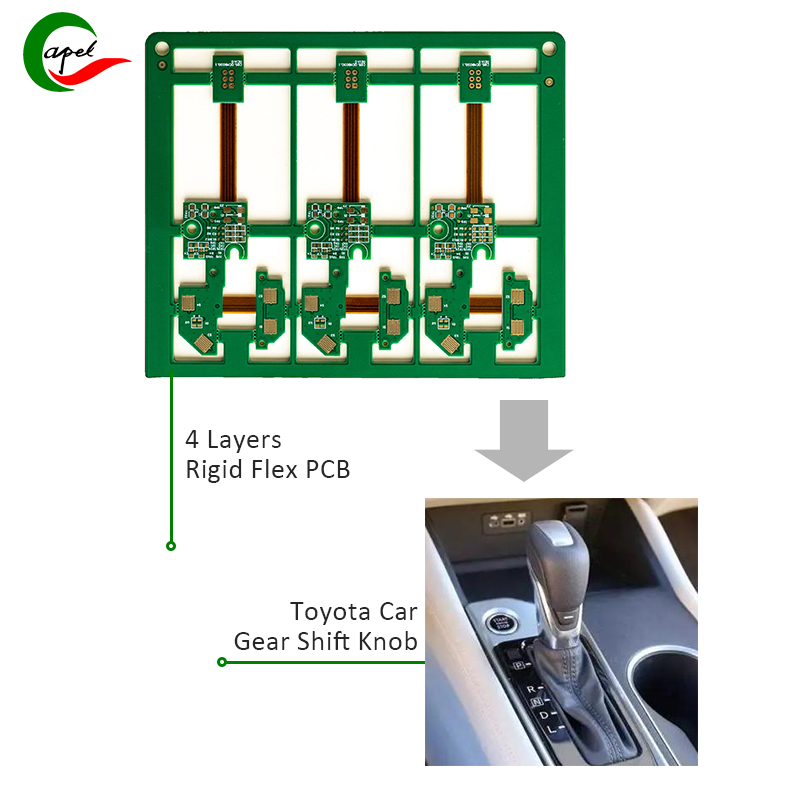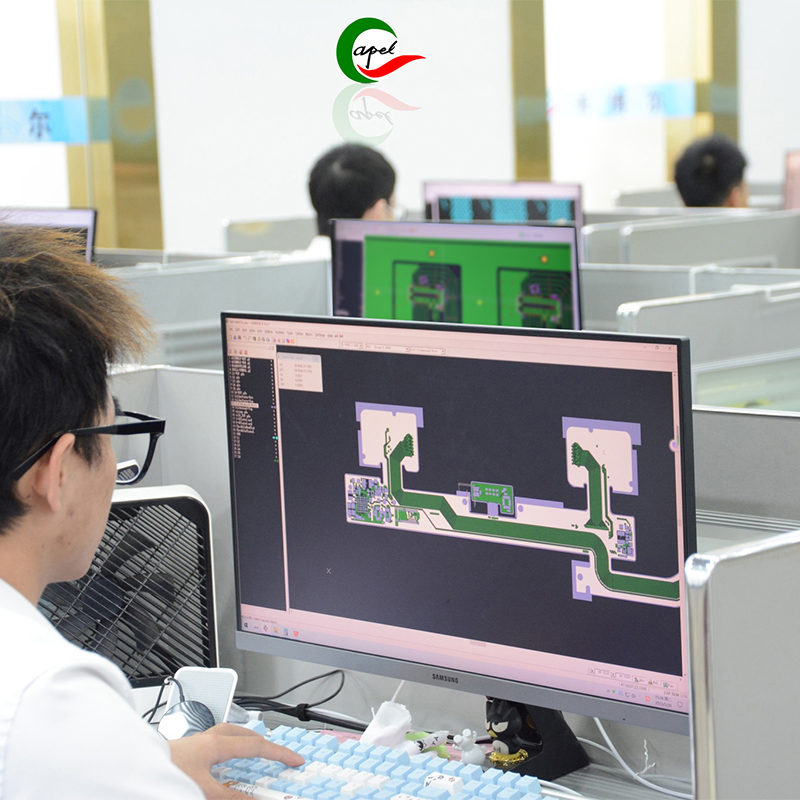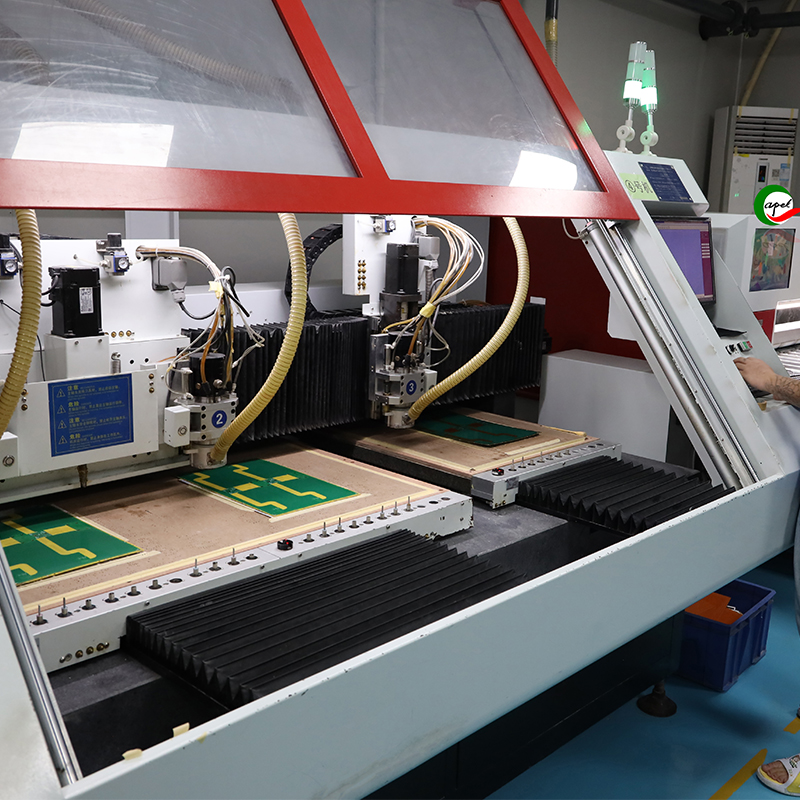what exactly are rigid-flex boards, and can they really be used in high-power applications? In this comprehensive guide, we’ll explore these questions and shed some light on the topic.
In today’s fast-paced technology environment, engineers and designers are constantly looking for innovative solutions to meet the growing demand for more powerful and compact electronic devices. One area where this is particularly important is in high-power applications. To meet the challenges posed by these demanding systems, many professionals are turning to rigid-flex printed circuit boards (PCBs).
I. Understanding Rigid Flex PCBs:
A. Definition of rigid flex PCBs
Rigid-flex PCB is a hybrid of traditional rigid PCB and flexible PCB. They consist of multiple layers of rigid and flexible substrates interconnected by flexible conductive materials. This design allows the PCB to bend and bend without compromising the integrity of the electronic connections, providing new design freedom and versatility.
B. Advantages and disadvantages of rigid flex PCBs
Advantages of rigid-flex board:
Space Optimization: Rigid-flex PCBs enable designers to efficiently utilize three-dimensional space because they can be bent, folded or twisted to fit the available area. Enhanced reliability: No connectors and interconnecting cables are required, reducing the possibility of mechanical failure and signal loss. Rigid-flex PCBs are also more resistant to vibration, shock, and temperature fluctuations. Improve signal integrity: By reducing interconnections and shortening transmission paths, rigid-flex PCBs minimize signal distortion, ensuring better performance and system reliability. Simplified assembly: Rigid-flex PCBs eliminate the need for complex assembly processes by eliminating the need for connectors and solder joints, minimizing the risk of human error and saving time during the manufacturing process. Cost-Effectiveness: Although more expensive than traditional PCBs, rigid-flex PCBs can save costs by reducing component count and eliminating the need for additional cables and connectors.
Disadvantages of rigid-flex board:
Complex designs: Designing rigid-flex PCBs requires specialized knowledge and expertise due to the combination of rigid and flexible materials. This complexity can result in increased development time and higher design costs. Initial cost: The initial cost of developing a rigid-flex PCB may be higher than a traditional PCB, making it less suitable for low-volume production or projects with limited budgets. Limited reworkability: Once a rigid-flex PCB is assembled, it is difficult to modify or repair because the flexible parts are very fragile and sensitive to changes
C. Applications of rigid flex PCBs
Rigid-flex boards are widely used in various industries, including: Aerospace and Defense: Rigid-flex PCBs are ideal for aerospace and defense applications due to their ability to withstand extreme conditions and high reliability. They are used in avionics systems, radars, satellites and military equipment. Medical Devices: Rigid-flex PCBs are increasingly used in medical devices due to their flexibility and compact form factor. They are used in pacemakers, implants, medical imaging systems and wearable health monitoring devices. Consumer Electronics: The consumer electronics market benefits from rigid-flex PCBs in devices such as smartphones, tablets, game consoles, and wearables. These PCBs enable smaller designs and improved functionality. Automotive industry: Rigid-flex PCB is suitable for automotive electronics, including advanced driver assistance systems (ADAS), infotainment systems, powertrains and lighting systems. They provide reliability and space optimization in harsh automotive environments.
2.Maximizing the potential of rigid-flex PCBs in high-power applications: Key considerations:
2.1.Power requirements and limitations:
A. Understand the power requirements: Before designing a rigid-flex PCB for high-power applications, the power requirements must be clearly defined. Determine the voltage, current and power levels the PCB needs to handle, taking into account peak and continuous operation.
B. Consider power limitations: Rigid-flex PCBs have specific maximum power ratings that should be considered during the design phase. PCB overloading can lead to overheating, voltage drops, and potential damage to components. Verify the power limits provided by the manufacturer and ensure the design meets these specifications.
2.2.Heat dissipation considerations:
A. Identify heating components: In high-power applications, certain components can generate large amounts of heat. Identify these components and consider their location on the rigid-flex PCB. Combine them to focus cooling efforts and ensure an optimal cooling strategy.
B. Implement effective thermal management techniques: Thermal dissipation is critical to maintaining performance and reliability in high-power applications. Incorporate thermal vias, heat sinks, and thermal pads into the PCB design to improve heat transfer. Additionally, if necessary, consider using advanced cooling methods, such as active cooling with fans or liquid cooling. three.
2.3.Component selection and placement:
A. Select the right components: Selecting components with the appropriate power handling capabilities is critical to the success of high-power applications. Choose components designed and rated for high-power use. Consider their temperature ratings, current carrying capabilities, and voltage limitations to ensure they can handle the required power levels.
B. Optimize component arrangement: The arrangement of components on a rigid-flex PCB can significantly affect its performance and heat dissipation capabilities. Gather high-power components together to ensure sufficient space for heat dissipation. Additionally, consider component proximity to minimize signal interference and optimize electrical performance.
2.4.Mechanical durability and reliability:
A. Choose Rugged Materials: High-power applications often involve harsh environments, vibrations, and mechanical stresses. Choose rigid and flexible materials with appropriate mechanical properties to ensure PCB durability and reliability. Consider the material’s stability, flexibility and resistance to moisture, chemicals and temperature fluctuations.
B. Reinforce the flexible area: In rigid-flex PCB, the flexible part is susceptible to mechanical stress and fatigue. Reinforce these areas with additional copper layers or polyimide coverings to increase their mechanical strength and extend the life of the PCB.
3.Benefits of Using Rigid Flex PCBs for High-Power Applications
A. Improved signal integrity
Rigid-flex PCBs significantly improve signal integrity, thereby enhancing the performance of high-power applications. By better controlling impedance, signal loss can be minimized, resulting in reliable, efficient signal transmission. The use of rigid sections helps reduce the occurrence of signal interruptions caused by vibration and mechanical stress, ensuring consistent high-quality performance.
B. Enhanced thermal management
Thermal dissipation is a key consideration in high-power applications, as excess heat can cause performance degradation and even cause irreversible damage to components. Rigid-flex PCBs have excellent thermal management capabilities, providing effective heat dissipation pathways and minimizing thermal stress. By using materials with excellent thermal conductivity and carefully placed thermal vias and heat sinks, these PCBs ensure optimal heat dissipation, ensuring system reliability and extending its lifespan.
C. Space-saving capabilities
As the demand for compact, efficient electronic systems continues to grow, the ability to save space has become an important aspect of PCB design. Rigid-flex PCBs excel in this area, supporting three-dimensional designs and making more efficient use of available space. Eliminating bulky connectors and interconnects reduces size and weight, which is especially valuable in high-power applications where space is limited.
D. Enhanced mechanical flexibility
Enhanced mechanical flexibility: Another advantage of rigid-flex PCBs is their excellent mechanical flexibility. The combination of rigid and flexible parts allows them to adapt to irregular shapes, bends and curves, making them ideal for applications requiring complex and compact designs. This flexibility also increases their resistance to mechanical stress, vibration and shock, ensuring reliable function in harsh environments.
E. Increased design possibilities
Rigid-flex PCBs open up a world of possibilities in terms of design flexibility. Manufacturers have the freedom to integrate various components and optimize their layout to improve electrical performance. The ability to customize PCB layout based on specific application requirements increases overall system efficiency and functionality. This flexibility becomes especially valuable in high-power applications, where space constraints and design complexity often pose significant challenges.
4.A Guide to Mastering High-Power Rigid-Flex PCB Design: The Road to Success introduce:
A. Adequate trace width and spacing:
A key consideration in designing high-power rigid-flex PCBs is ensuring adequate trace width and spacing. Wider traces enable efficient current flow and minimize resistance, reducing the risk of overheating and ensuring optimal performance. Proper spacing between traces helps prevent potential crosstalk and interference and maintains signal integrity. Following industry standards for trace width and spacing is critical to ensuring the safety, reliability, and stability of high-power applications.
B. Proper layer stack-up and material selection:
Layer stackup and material selection significantly affect the performance and durability of high-power rigid-flex PCBs. Sufficient layer stacking enables efficient power distribution and signal transmission while minimizing noise interference. Careful selection of the right materials, such as high-quality laminates and copper foil with good thermal conductivity, can help enhance heat dissipation and overall reliability.
C. Component placement and routing considerations:
Efficient component placement and routing are critical for optimal functionality of high-power rigid-flex PCBs. Strategic component placement minimizes signal path length, reduces voltage drop and improves signal quality. When designing PCBs for high-power applications, it is critical to understand the thermal characteristics of components. Proper routing techniques, such as avoiding sharp bends and using differential pairs when necessary, can help manage noise and ensure signal integrity.
D. Thermal management techniques:
Thermal management is critical to preventing overheating and maintaining the stability of high-power rigid-flex PCBs. Incorporating technologies such as thermal vias, heat sinks and utilizing strategic copper areas help dissipate heat and prevent components from reaching critical temperatures. It is important to consider the thermal characteristics of materials and components during the design phase to ensure proper ventilation and effective heat dissipation, thereby extending the life of the PCB.
E. Compliance with safety standards:
In high-power applications, safety is paramount and ensuring compliance with relevant safety standards is critical. Compliance with standards such as UL, IEC, and IPC ensures that PCB designs meet industry requirements for electrical insulation, flammability, and protection against potential hazards. Complying with safety standards ensures the reliability and integrity of high-power rigid-flex PCBs, ensuring safe operation for end users.
5.How rigid-flex PCBs are revolutionizing high-power applications:
A. Example 1: Automotive industry:
The automotive industry is at the forefront of innovation, constantly pushing boundaries to improve vehicle performance, safety and efficiency. Rigid-flex PCBs have played a vital role in the transformation of this field, promoting the development of advanced electronic systems. In high-power automotive applications such as electric vehicles (EVs), rigid-flex PCBs pave the way for improved power management, compact designs and unparalleled reliability. Their flexibility enables seamless integration into limited spaces, eliminating the need for bulky wiring harnesses and reducing weight. Rigid-flex PCBs revolutionize battery management systems, motor control units and other critical components, ensuring efficient power distribution, enabling longer driving ranges and improving overall vehicle performance – setting new standards for the automotive industry.
B. Example 2: Aerospace and defense industry:
In the aerospace and defense industry, precision, durability and reliability are critical. Rigid-flex PCBs have proven to be a game-changer in meeting the stringent requirements of high-power applications in this field. Aerospace systems, such as flight control systems, avionics and communications systems, require rugged and resilient electronic components to withstand extreme conditions. Rigid-flex PCBs offer unparalleled mechanical stability due to the combination of rigid and flexible layers, allowing them to withstand vibration, shock, and temperature changes without compromising performance. Additionally, its compact form factor and reduced weight contribute to improved fuel efficiency and increased payload capacity. By adopting rigid-flex PCBs, the aerospace and defense industry has made significant advances in mission-critical applications, enhancing performance and ensuring unwavering reliability.
C. Example 3: Renewable energy sector:
The renewable energy industry faces the challenge of harnessing and efficiently distributing electricity from renewable sources such as solar and wind. Rigid-flex PCBs have become an essential component of the industry, driving innovation and enabling seamless integration of complex power electronics devices. Solar inverters, smart grid systems and wind turbine controls all rely on the high power capabilities and durability of rigid-flex PCBs. Their ability to withstand harsh environmental conditions, coupled with excellent thermal management properties, ensures reliable operation and longer service life. Rigid-flexible PCBs help improve the overall efficiency of renewable energy systems, enabling precise power conversion, intelligent monitoring and efficient use of sustainable energy.
6.Overcoming challenges and reducing risks in high-power applications with rigid-flex PCBs:
A. Cost considerations:
Cost is an important factor that decision makers need to weigh when considering rigid-flex PCBs for high-power applications. Compared to traditional rigid PCBs, rigid-flex PCBs tend to be more expensive due to the additional design, materials, and manufacturing complexities involved. Combining rigid and flexible components requires precise engineering and complex structures, resulting in higher production costs. However, it must be viewed as an investment rather than a limitation. The cost of using rigid-flex PCBs can be justified by the numerous benefits it brings, such as enhanced reliability, reduced weight, space savings, and improved durability. By understanding the long-term benefits and conducting a thorough cost-benefit analysis, companies can make informed decisions and maximize return on investment when integrating rigid-flex PCBs into high-power applications.
B. Manufacturing complexities:
Manufacturing rigid-flex PCBs for high-power applications presents unique challenges due to their complex designs and demanding specifications. The integration of rigid and flexible components requires complex manufacturing processes and specialized equipment. Precise alignment of the layers, ensuring reliable electrical connections, and maintaining mechanical strength throughout the life of the circuit board all require careful attention to detail. Manufacturers need to invest in advanced machinery, hire skilled technicians and implement strict quality control measures to reduce risks in the production process. Working with an experienced and reputable rigid-flex PCB manufacturer is critical to ensuring successful execution of high-power applications. By leveraging the expertise of these manufacturers, companies can minimize manufacturing complexity and ensure the delivery of reliable and high-quality products.
C. Limited availability of specialized suppliers:
Another challenge when using rigid-flex PCBs for high-power applications is the limited number of specialized suppliers. Complex structures and complicated manufacturing processes have prevented many PCB manufacturers from venturing into this niche market. Therefore, finding reliable and knowledgeable suppliers can be challenging. Working with a supplier that is proficient in rigid-flex PCB technology is critical for access to quality materials, industry-specific expertise and technical support. Working closely with these specialized suppliers helps reduce potential risks, ensure the right parts and materials are sourced, and streamline the entire production process. Building long-term relationships with trusted suppliers is an excellent strategy that not only alleviates limited availability challenges, but also fosters collaboration and innovation within the high-power industry.
In Summary:
Rigid-flex PCBs are an excellent choice for high-power applications. Their ability to handle thermal stress, compact size and enhanced signal integrity make them a reliable, efficient solution. However, correct design considerations and material selection are critical to achieving optimal results. Consulting with experienced PCB professionals is an integral part of the process.
If you are looking for a solution to your high-power application needs, consider exploring the benefits of rigid-flex PCB technology. With their unique design and functionality, these boards can help you meet the needs of the ever-evolving electronics world.-Capel with 15 years of professional technical experience in Rigid Flexible PCB industry.
Post time: Sep-16-2023
Back










